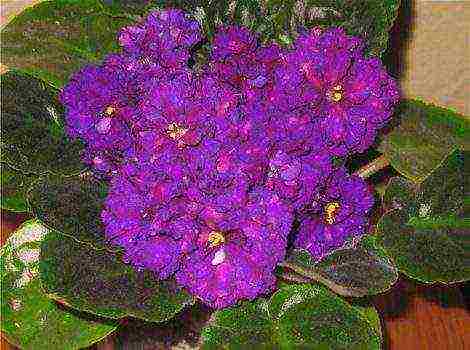Content
- 1 Frost-resistant blackberry varieties for the Moscow region and the middle zone
- 2 New thornless blackberry varieties
- 3 What is kumanika and dew grass?
- 4 The best varieties of blackberries for the Moscow region
- 5 ★ The best blackberry varieties by ripening time
- 6 The most productive varieties of blackberries
- 7 How to prepare the soil for blackberries in the Moscow region?
- 8 Blackberry Care (Highlights)
- 9 Answers to frequently asked questions about the blackberry
- 10 Gardeners' mistakes when growing blackberries in the Moscow region
- 11 Agave
- 12 Apaches
- 13 Black Satin
- 14 Karaka Black
- 15 Ruben
- 16 Thornfree
- 17 Chester
- 18 Short description
- 19 The best varieties of blackberries
- 20 Video tips for growing blackberries
In recent years, more and more gardeners have begun to plant blackberries on their plots. Despite the fact that this culture is relatively new for us, nurseries offer a large selection of seedlings. The choice is so large that it is easy for an unprepared person to get confused. To prevent this from happening, we will now try to figure out what varieties of blackberries are and what is their difference.
On this page, the most promising and demanded varieties of this plant are selected, with a description of each variety, photographs and brief planting recommendations.
Depending on the structure of the bush, these plants are conventionally divided into:
- Kumaniks are more like raspberries. The stems of older varieties are thorny, grow upward and require support. They reproduce, like raspberries, by root suckers. Kumanik winter hardiness is high, but most still need shelter for the winter.
- Rosyaniki - similar to a wild blackberry with long creeping shoots. There are varieties with thorny shoots, and there are no thorns at all. It is also grown on trellises. Propagated by dropping shoots. The yield is higher and the berry taste is usually better than that of kumanik. Frost resistance is low, it is necessary to cover for the winter.
Blackberries, like raspberries, have a two-year development cycle: in the first year, the shoots grow, lay fruit buds, the next year they bear fruit and after harvesting they are cut out. The exceptions are remontant blackberry varieties that bear fruit on both young and last year's shoots.
In most of our country, winters are quite harsh and in this regard, most gardeners are interested in frost-resistant plants. Thornless varieties and remontant blackberry varieties are in great demand. They all have their pros and cons.
Frost-resistant varieties of blackberries for the Moscow region and the middle zone
Blackberry variety Agavam
Agave
Agave Is an old and very frost-resistant blackberry variety. It is even included in the State Register of varieties recommended for cultivation in the Russian Federation. It can be grown not only in the Moscow region, but also in Siberia.
- Productivity 3 - 6 kg. sometimes up to 10 kg. from one bush
- Berries weigh 3 - 5 grams, sweet taste, ripen in July - August.
- Fruiting lasts at least 15 years
- Shoots are erect, powerful, rigid with sharp thorns, 2.5 - 3 meters high
- Withstands frosts down to -40º, no shelter required for the winter
Advantages of the variety: beautiful flowering, stable fruiting, no need to cover for the winter, drought-resistant and shade-tolerant, grows on any soil and is generally very unpretentious.
Flaws: thorny shoots cause a lot of inconvenience, gives a lot of overgrowth.
In the south, Agaves can be grown both in the shade and in the sun.In the northern regions, berries in the shade may not have time to ripen, so planting in the sun is recommended. When planting, the root collar is deepened a few centimeters. The distance between the bushes is 1 meter, between the rows 1.8 - 2 meters. Although the shoots are strong, it is better to tie them up with a fan to the trellises.
Reviews - very controversial. There are ardent supporters of this variety, but there are also ardent opponents who complain that Agavam shoots have filled the entire garden.
Blackberry Polar
Polar
Polar - frost-resistant, thornless, early, large-fruited garden blackberry of Polish selection.
- Productivity 5 - 6 kg. berries from each bush (when wintering without shelter)
- The berries are very large, 10-12 g, sweet, in the southern regions they begin to sing in early July.
- Withstands frosts down to -30º shelter is not necessary. But most gardeners note that if the bushes are covered for the winter, the yield increases several times. From this it follows that the fruit buds still freeze slightly and the shelter will not be superfluous at all.
- Stems are upright up to 2.5 m, strong, without thorns. They can break when bent to the ground. To facilitate the task, it is necessary to start tilting the shoots in advance, until they are lignified.
Advantages of the variety: frost resistance, large and tasty berries, thornless shoots, disease resistance, early ripening of the crop, good transportability.
Flaws: perhaps only one - it is difficult to bend the shoots to the ground for the winter.
Prefers to grow in the sun, on drained loamy soils. Dislikes damp, waterlogged places.
Reviews: only positive.
Unfortunately, the choice of frost-resistant blackberry varieties is not great. Only Agavam and Polar can winter without shelter, but it is better to cover Polar for the winter. All other varieties of this plant require mandatory shelter.
New thornless blackberry varieties
Currently, surprisingly productive varieties of kumanik and dewdrop have appeared on the market. From one bush, you can collect 2 - 3 buckets of healthy and tasty berries. The mass of these berries is so great that buyers in the market refuse to take them, thinking that they are stuffed with all kinds of chemicals. After reading the description of these varieties, you will understand that this is not an exaggeration.
Natchez
Natchez
Natchez - early ripe, very large-fruited, thornless blackberry variety.
- Productivity up to 20 kg from each bush
- The berries are very large, weighing 10 - 12 grams. sweet taste, begin to sing in June. Fruiting lasts 35 - 40 days
- Semi-erect bushes, shoots up to three meters long.
- For the winter, a cover with agrofibre is required, which is removed only after the soil thaws and the buds swell. If the bush is opened earlier, then the shoots may dry out and the plant will die. This rule also applies to other varieties of blackberries.
- When planting, you must maintain a distance between bushes 3 and between rows 2 meters
Advantages: high yield, large-fruited, early ripening, good keeping quality and transportability of berries, extended fruiting period
Flaws: low winter hardiness, a small number of replacement shoots.
Reviews: The reviews are very good, with a little controversy about Natchez's taste. The fruits of this blackberry variety have a sweet taste, but there is a slight bitterness in it, some do not like it, others believe that it is the bitterness that gives such a unique and refined taste to these berries, and many did not feel bitterness at all.
Ouachita
Ouachita
Ouachita - thornless, large-fruited blackberries of early ripening
- The declared yield of this variety reaches 30 kg. from every bush
- Large berries 6 - 7 gr. and with a very original taste, they begin to ripen in June. Fruiting is extended and lasts almost two months.
- Bushes are powerful erect, shoots grow up to 2.5 - 3 meters. Grown on a trellis, usually with three rows of wire.
- For the winter, the plant must be covered.
- When planting in a bush method, the distance between blackberry seedlings is 1.5 - 2 meters.
Advantages: a very extended ripening period, amazing productivity, disease resistance, berries with an original taste do not lose their marketable qualities for a long time.
Flaws: weak frost resistance -17º, the need to bend down rather thick shoots.
The proposed video is in English, but it clearly shows what kind of crop can be harvested from this plant. By the way, Ouachita, Auchita, Ouachita and Ouachita are the names of the same total variety, the description of which you just read.
Reviews positive - the variety is easy to grow, not capricious. Farmers love the combination of high yields and moderately large berries with great flavor.
Chester
Chester
Chester is an old, well-known, thornless, large-fruited late-ripening blackberry.
- The declared yield is 15 - 20 kg. from every bush
- The berries are sweet with a slight sourness, weighing from 5 to 8 grams, ripen in late July or early August.
- The plant has a semi-sheathing bush shape. No more than 5 - 6 shoots are left for fruiting, which grow 2 - 3 meters long.
- Despite the frost resistance down to -26 ° C, shelter is required for the winter period.
- When planting, you must maintain a distance between the bushes of 2 - 2.5 meters.
Advantages: high frost resistance, absence of thorny thorns, excellent yield, good transportability of berries, the variety is resistant to major diseases and pests.
Flaws: despite good frost resistance, winter shelter is required. Poorly tolerates shading and planting in damp lowlands.
Reviews: only positive, many consider Chester to be the best variety in their collection and allocate the best places for it.
Black Satin
Black Satin
Black Satin - as well as Chester, a rather old variety of thornless garden blackberry, medium ripening.
- The average yield is 10 - 15 kg, and with high agricultural technology up to 20 - 25 kg.
- Berries weighing about 5 grams, collected in large clusters. Taste from sweet - sour to sweet, ripen in mid - late July.
- Bushes are semi-creeping. Stems are tough, up to 5 meters long. It is recommended that young shoots be immediately pressed to the ground and grown in an inclined position, then it will be easier to cover for the winter.
- Frost resistance - 22 ° C and winter shelter is required in most regions.
- For cultivation, you will need a trellis with a height of about two meters.
Advantages of the variety: absence of thorny thorns, high productivity, unpretentiousness, resistance to diseases.
Flaws: the need to cover for the winter every year, tough shoots that often break when bending to the ground, poor transportability of berries.
Reviews: generally positive, generous, unpretentious variety, winters well under cover. But the berries overripe quickly, you can not be late with the collection. For commercial purposes, not the best option.
Loch Tei
Loch Tei
Loch Tei - large-fruited, non-prickly blackberry of medium ripening.
- The declared yield is 10 - 12 kg. from every bush. Most gardeners claim that this is the case.
- The berries are large, weighing about 5 grams. The taste is sweet with sourness, ripening in mid-July.
- Loch Tei has a semi-sheathing bush shape. Shoots are vigorous, resilient, up to 5 meters long, requiring trellis.
- The frost resistance of this blackberry variety is 20 ° C. It is not enough for our country, for the winter it is necessary to cover it.
- When planting, the distance between the bushes is at least 2 m.
- Propagated by dropping the tops of the replacement shoots.
Advantages: good yield, lack of thorny thorns, excellent berry taste and excellent transportability.
Flaws: the need to cover the plant for wintering every year.
Reviews: According to most gardeners, Loch Tei is one of the best varieties of garden blackberries.
Kiova
Kiova
Kiova - blackberries with the largest berries. Unfortunately this variety has sharp thorns, but it is included in the description due to its exceptional large size.
- The yield of Kiova exceeds 30 kg. berries from one bush.
- Huge berries weigh 20 - 25 grams. They start singing at the end of July.
- The bush is upright, the height of the shoots is 1.6 - 2 meters, they require support.
- This blackberry tolerates frosts up to -23 degrees without loss. Without shelter, it can winter only in the southern regions.
Advantages: very productive variety, surprisingly large and tasty berries, good transportability, the ability to surprise neighbors.
Flaws: the presence of sharp thorns, the need to cover the bushes annually for the winter.
All reviews something like this: when I cover the bushes for the winter, I swear that I am suffering with these thorns for the last time, and when I start harvesting I understand that this blackberry will always grow with me.
Columbia Star
Columbia Star
Columbia Star - a new, little-known, thornless variety of early ripening blackberries.
- According to the manufacturer, Columbia Star will be one of the most productive varieties (16750 kg / ha)
- Berries of the same size, elongated, weighing 10 - 15 grams, begin to ripen in late June - early July.
- Creeping type bushes, shoots 4 - 5 meters long, without thorns.
- Columbia's winter hardiness is low - 14 degrees, winter shelter is required.
Advantages: tasty, large berries retain their presentation for a long time, high yield, rather soft and thornless shoots are easy to press to the ground for winter shelter. The variety easily tolerates heat and drought.
Flaws: long shoots with many lateral shoots can be difficult to untangle when removed from a support.
Reviews: gardeners who managed to plant Columbia have not yet been able to fully appreciate this variety, but everyone notes the high taste of the berries. It is considered by many to be the most promising new product.
Chachanska Bestrna
Chachanska Bestrna
Chachanska Bestrna - a high-yielding, thornless variety of early ripening blackberries.
- Productivity 12 - 15 kg. berries from one bush.
- Sweet and sour berries weighing 9-14 grams, begin to ripen in early July.
- Semi-creeping bushes, powerful shoots without thorns, grow up to 3 - 3.5 meters. A garter to the supports is required.
- The frost resistance of the variety is relatively high -26º, but it still has to be covered.
Unfortunately, the video is not of high quality, but this is all that we could find:
Advantages: high productivity, drought resistance, unpretentiousness, immunity to major diseases.
Flaws: poor transportability, ripe berries every other day - another begins to flow. True, for amateur gardening, this disadvantage is not very important.
Reviews: all the reviews are good, this variety has proven itself well in the southern and northern regions.
Doyle
Doyle
Doyle - one of the best varieties of thornless blackberries. It claims to be the most productive variety.
- Doyle's documented yield is 5-7 buckets of berries per bush.
- Berries are sweet and sour, weighing 7 - 9 grams. Ripens later - mid-August.
- Semi-erect bushes with long, up to 5 - 6 m shoots, no thorns. Trellis required for cultivation
- It is necessary to cover for the winter.
Advantages: amazing productivity, easily tolerates heat and drought.
Flaws: this blackberry is more suitable for the southern regions, in the northern regions it may not have time to ripen.
Reviews: there are very few reviews, in Russia this variety has been cultivated for only a few years.
Waldo
Valdo
Waldo Is an old and proven, thornless, creeping blackberry variety of medium early ripening.
- The authors of the variety promise a yield of 15 - 17 kg. berries from one bush.
- Berries weighing 6 - 8 grams. have a pleasant taste and aroma, they begin to sing in the first decade of July.
- Creeping bushes, compact. The length of the shoots does not exceed 2 meters, but support is needed.
- Average winter hardiness, winter shelter for this blackberry is required.
Advantages: no thorns, easy to cover for the winter, ideal for small areas.
Flaws: in hot weather, berries can be baked.
Loch Ness ‘Loch Ness’
Loch Ness
Loch Ness - thornless, very productive blackberry, medium late ripening.
- The yield of this variety can reach 25 kg. from every bush.
- The berries are sweet, with sourness, similar to the taste of wild blackberries 5 - 8 gr. They begin to ripen at the end of July.
- Loch Ness bushes are vigorous, semi-sheathing. Stems up to 4 meters long, need support.
- Winter hardiness for our climate is not high enough, the bushes have to be covered in winter.
- When planting, the distance between the bushes is at least 2 meters.
Advantages: consistently high productivity, unpretentious in care, quickly and easily multiplies, suitable for commercial use.
Flaws: ripens late, in a rainy summer the taste becomes sour.
Reviews: unequivocally good - with minimal maintenance, always an excellent harvest.
Oregon Thornless
Oregon Thornless
Oregon Thornless - thornless, creeping blackberry of late ripening.
- Average yield, about 10 kg. berries from each bush.
- Berries are sweet and sour, large, weighing 7 - 9 grams, ripen in August.
- The plant forms creeping bushes, with thornless shoots up to 4 meters long. Trellis required for cultivation.
- Oregon can withstand temperatures as low as -29 degrees, which is clearly not enough for the middle zone, and you cannot do without shelter.
Advantages of the variety: excellent taste, lack of thorny thorns, easy to cover for the winter, the decorativeness of the plant allows you to use it for decorating gazebos, arches and other buildings.
Reviews: "I have this variety in my favorites - the most problem-free - it winters well (under cover), replacement shoots appear immediately, almost simultaneously with the start of fruit shoots growth, the size of the berry with sufficient watering is really large, sweet taste, very fruitful."
Osage
Osage
Osage - thornless blackberry with ideal taste. This variety is considered the most delicious of all blackberry varieties.
- The yield is relatively low, 3 kg. berries from each bush.
- Berries with a perfectly balanced taste and a weight of 6 - 7 grams. begin to sing in the first decade of July.
- Bushes are erect, shoots without thorns, about 2 meters high.
- Low frost resistance, only -13º, shelter is required.
Advantages: exquisite, dessert taste, the sweetest of all varieties of blackberries, never sets the teeth on edge.
Flaws: low winter hardiness and relatively low productivity.
Description of remontant blackberry varieties
Repaired blackberry varieties can be grown for one crop or two. In the first case, all the shoots are cut to the root in the fall and a completely empty bed is in the winter. In the spring, young shoots begin to grow from the roots at the end of August, berries begin to sing on them.
To get two full-fledged harvests next year, only last year's shoots are cut in the fall, and the young are bent to the ground, covered and allowed into the winter. In June next year, berries begin to sing on these shoots. At the end of July, having collected the entire crop, these shoots are cut out. And already at the end of August, young shoots that have grown over the summer begin to bear fruit. Thus, you feast on blackberries for almost the entire summer season.
Unfortunately, all this pleasure is available only to residents of the southern regions. In the northern regions, remontant blackberry varieties do not justify themselves. It is not uncommon for some of the berries to die from frost. The first crop (partially or completely) may die during the flowering stage from recurrent frosts. The second will begin to sing only at the end of August, or even at the beginning of September. The berries simply do not have time to ripen and part of the harvest goes under the snow.
Freedom
Freedom
Prime-Ark Freedom Is a studless, remontant blackberry variety.
- The authors of the variety promise high yields. The variety is new and there are no exact numbers yet.
- The berries are sweet, large, weighing 15 - 20 grams, the first harvest begins to sing from mid-June, and the second in the third decade of August.
- Bushes are erect, medium-sized, stems without thorns about 2 meters high.
- Shelter is required for the winter.
- Propagated by root shoots and cuttings.
Advantages: high productivity, excellent quality of fruits and excellent taste, the ability to receive products throughout the summer.
Flaws: low winter hardiness, the variety is recommended only for the southern regions, the need to bend down and cover the shoots for the winter.
Photo taken from the forum: Black Magic (Black Magic)
Black Magic
Black Magic (Black Magic) - remontant blackberry variety (stems with thorns)
- Productivity from 5 kg. from one bush.
- The berries are sweet, weigh an average of 7 - 10 grams. Ripening terms - the end of June, the first harvest and the last decade of August, the second harvest.
- Shoots are strong, about 1.5 meters high, there are relatively few thorns.
- Weak winter hardiness -12º, winter shelter is required.
Advantages: this variety is best adapted to the climatic conditions of our country. Excellent fruit quality, High productivity, tolerates heat and drought well.
Flaws: thorny shoots, low frost resistance, strong shoots are difficult to press to the ground.
Reuben
Ruben
Reuben - remontant, large-fruited variety of garden blackberry (with thorns)
- Productivity from 6 kg. from one bush.
- The fruits are sweet, large, with an average weight of about 10 grams. Ripen in late June and late August.
- Shoots are erect, medium-sized with thorns.
- The plant can withstand a drop in temperature down to -16º, a shelter is required.
Dignity: variety resistant to frost, tolerates shading well, excellent transportability of berries.
Flaws: the main disadvantage is the sterilization of pollen already at + 30º
Prime-Ark 45
Prime Arc 45
Prime-Ark 45 - a new remontant blackberry variety (with thorns).
- Producers promise good yields, but no specific data is available yet.
- Berries are transportable, sweet taste and weighing 6 - 8 grams.
- Bushes are erect, with a moderate number of thorns. They tolerate heat and drought well.
- It does not hibernate without shelter.
Traveller - Prime-Ark Traveler
Traveller
Traveller - Prime-Ark Traveler - new, studless remontant blackberry.
- This variety is still little studied, but the Americans claim that productivity will be at its best.
- Berry weight 7 - 8 gr. The taste is sweet and sour.
- Bushes are erect, about two meters high, without thorns
- When grown for two harvests, the shoots are bent to the ground in autumn and covered with spunbond in 2 - 3 layers.
Save article to:
Dear visitors of the "Dacha Plot", tireless gardeners, gardeners and flower growers. We offer you to pass the aptitude test and find out whether you can trust the shovel and let you into the garden with it.
Test - "What kind of summer resident I am"
Share this article with your friends:
Blackberries are less popular among Russians than raspberries. But all the same, she also has her fans. Blackberry fruits are incredibly useful, even diabetics can eat them without fear. If we talk about which variety is better to plant, then the region where cultivation is supposed to be of great importance, as well as taste inclinations. Consider the best varieties of blackberries for the Moscow region.
What is kumanika and dew grass?
The Moscow region (and more northern ones) prefers frost-resistant varieties with juicy, not very large berries, which are represented by erect plants up to three meters high with a drooping crown. This is kumanika. There is a great similarity between kumanika and raspberry. This group includes varieties such as Eldorado, Kittatinny, Lawton, Erie, Darrow.
But in more southern regions, where winters are not so cold, creeping varieties, which are united by one name - dewweed, take root better. The dewdrop can grow up to six meters in length, its fruits are much larger than those of kumanika.
The best varieties of blackberries for the Moscow region
In the middle Russian regions and specifically in the Moscow region, specially bred blackberries are grown, suitable for the harsh climate of these places. Despite its ability to withstand thirty-degree frosts, nevertheless, the stems should be bent closer to the ground before winter and preferably covered.
Frost-resistant varieties of blackberries for the Moscow region
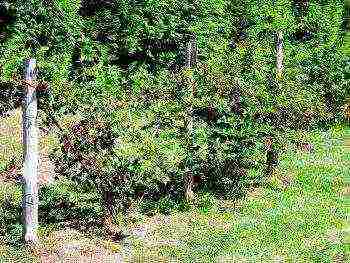
This is what kumanik bushes look like. Although they are erect, it is better to tie them up on a support.
Frost-resistant varieties include:
- Agave is one of the best varieties for the Middle Lane, it tolerates even forty-degree frosts without shelter, however, with the loss of a small part of the fruit buds. The plant is powerful, tall, so it is not possible to bend it down for the winter, prickly, but unpretentious. As proof of unpretentiousness, it continues to grow and even bears fruit successfully in a long-abandoned area. From one bush, you can remove about four kilograms of black fragrant sweet and sour berries, each of which weighs at least five grams. And if you properly care for this variety, feeding it on time and cutting it off without regret, then the yield will be at least five kilograms, and the weight of one berry will reach ten grams.
- Darrow - high winter hardiness, tolerates 35-degree frost without problems. A plant with a powerful, tall trunk and thorny thorns. The yield is good, the weight of one berry is about 4 grams.
- Wilson Earley - tolerates winter cold well, is considered one of the earliest, ripening of berries begins in July. Has good disease resistance. The plant is tall with straight shoots drooping to the ground, because of this, it is necessary to tie them to a trellis. The black-purple berries are not very large, only about two grams, they resemble an egg in shape.
Shipless blackberry varieties for the Moscow region
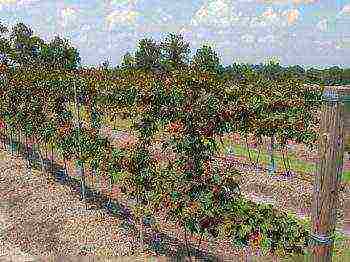
This is what dew bushes look like. Their long lashes must be tied up on a trellis.
Blackberries in the wild are impassable thorny thickets. At the mention of a bush, such a picture arises in the imagination. And it is precisely because of these qualities that many gardeners do not have a desire to plant this plant in their area. But time does not stand still, breeders work conscientiously, and varieties of blackberries have already appeared absolutely without thorns, to the delight of lovers of this delicious and wholesome berry. Such varieties, of course, are gaining frenzied popularity, since they do not cause much trouble in harvesting and caring for plants. Usually these bushes have a strong root system. They are comfortable with the lack of water.
The most famous studless grades include:
- Thornfree – the first studless American variety to appear in Russia. From the genus of large-fruited mildew, if not cut off, it can reach five meters in length. A plant with large, fragrant, very sweet (without a hint of acid) berries weighing up to six to seven grams and up to four centimeters long. The fruits become soft when fully ripe, so they have a short shelf life. In the climate near Moscow, this variety requires a mandatory winter shelter. Usually, the shoots are pressed to the ground and covered with soil or mulch, which will be covered by a snowdrift in winter.
- Black Satin - we crossed several varieties (including Thornfree) and got a studless Black Satin. When it starts to grow, it looks erect, and later the shoots become drooping and, if they are not cut off, grow up to 4.5-5 m.A plant with large sweet and sour berries (up to 8 g) does not matter frost, so it should be shelter for the winter.
- Apaches are an excellent thornless variety of medium ripening (from about July) with black, sweet, large (up to 10 grams) berries. This variety is characterized by a very high yield, frost resistance and disease resistance.
This group of blackberries also includes such varieties as Loch Tay, Boysenberry, Orcan, Dirksen, Smutsen, Chester.
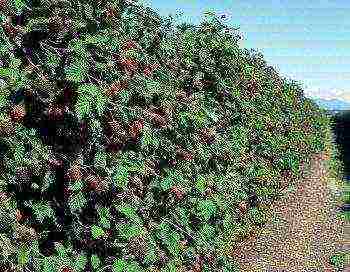
Thornfree, Black Satin varieties are great for hedges
Repairing varieties of blackberries for the Moscow region
Low compact bushes of remontant blackberries still need a garter to the trellis when the harvest begins to ripen. The main feature of this variety is that the plant gives two harvests in one season. One - in June, it is harvested from last year's shoots, the other - in August, the berries ripen on the current shoots, the harvest is much larger than the first... In the case of complete pruning of shoots before winter, two harvests will not work, since there will be no last year's branches, there will be one, but what a! The best remontant blackberry varieties: Prime Yang, Prime Arc 45, Black Magic, Prime Jim.
The most famous and most productive of the remontant blackberry is the Ruben variety. It belongs to the upright blackberry. Bushes with thick strong shoots up to two meters high bear very large berries (up to 14 grams). This variety is renowned for its resistance to disease and frost. It does not show special requirements for the ground, a garter is not needed. Last year's shoots bear fruit in June, current shoots bear fruit from late August to late autumn.
Tip # 1. If, after fruiting, all the bushes are completely cut to the ground, they will winter safely, covered with snowdrifts, and in the spring the root system will throw out many new young shoots, which will give only one harvest, but very high.
★ The best blackberry varieties by ripening time
There are three groups of varieties according to the ripening period of blackberries:
- Early. The ripening period of the earliest blackberries is the beginning of summer, June. The berries of these varieties are juicy enough, but not sweet enough, one might even say sour and do not have the proper aroma. But on the other hand, this is one of the first berries of the season. The most popular among early and mid-early varieties are Natchez, Helen, Loch Tay, Arpaho, Asterina, Agavam, Columbia Star, Karaka Black.
- Medium to mid-late. Take the baton from the early maturing blackberries, continuing the harvest period from about mid-July. These varieties yield a more amicable harvest, and the juice from the berries turns out to be thicker and richer. The most popular varieties: Triple Crown, Bristol, Auchita, Jumbo, Marion, Loch Ness, Black Satin, Lawton, Chachanska Bestrna.
- Late. Mid-August - late blackberries are ripening. The berries are preserved or for juice. Most popular varieties: Navajo, Chester Thornless, Texas, Chokeberry.
The most productive varieties of blackberries
New varieties of blackberries appear every year. But many gardeners - conservatives by nature - are not even aware of the success of breeders, continuing to grow well-known, but, unfortunately, outdated varieties.
Familiar varieties of blackberries
These varieties include Thornfrey, which appeared more than fifty years ago. Of course, it has a number of advantages: tenonlessness, which means convenience in growing, good yield, early ripening, unpretentiousness, winter hardiness, etc. In industrial cultivation, blackberries are one of the best varieties.
Older blackberry varieties are prized for their long-term acclimatization. But there are also many new varieties, sometimes even superior in quality to the old ones, which are grown in local nurseries. Such varieties are better adapted to the climatic conditions of the growing region, they tolerate transplanting better, as a result of which they begin to bear fruit faster. Agave blackberries, which were described above, can also be ranked among the time-tested varieties.
The latest varieties of blackberries
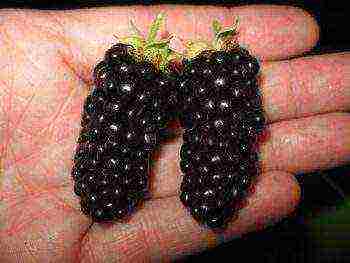
One of the largest blackberry varieties Kara Black. It is of commercial interest due to its appearance and good transportability.
Breeders all over the world are making truly seven-league strides in breeding new varieties. If earlier new items appeared mainly in America, now other countries are delighting with new types of blackberries.
For example, the Karaka Black variety came to the world from New Zealand. This variety can rightfully be called an ordinary miracle and the most promising of the newest varieties.Kara Black is a super early variety, and the berries ripen and ripen on the bushes until late autumn. They are just huge! The weight of one berry reaches 30 grams! For taste, you can put "excellent", sweet and very juicy. Despite their juiciness, they have good transportability, and, accordingly, are of commercial interest. It tolerates drought very well and is immune to any disease. The bush is rather compact, with small (up to 3 m) lashes, with a few thorns. The only drawback is that it does not tolerate frost well. But if you properly cover the lashes, which bend perfectly and do not break, then there will be no problems with wintering.
But the biggest fruit is Natchez, a new breeding product developed in the state of Arkansas. A bushless bush of a semi-standing shape is very convenient to lay for a winter shelter in a trench. The berries reach 4 cm in length and ripen at the end of June. The taste is excellent, not even ripe, the fruits are still sweet with a pleasant cherry aftertaste. They tolerate transportation very well, and if we add super early ripening here, then the commercial interest is obvious.
The most popular varieties from this group: Lucretia, Thornfrey, Eldorado, Erie, Izobilnaya, Agavam, Smustem, Boysen, Black-fruited, Texas.
How to prepare the soil for blackberries in the Moscow region?
The soil for planting blackberries must be prepared. Lightness of the soil and good drainage are the main indicators, since stagnant water in the soil is not for blackberries. Kumanika prefers loamy or sandy loam soil. The dewweeds have less soil requirements - heavier soils are also suitable, as long as they are fertile. In any case, if the soil lacks the necessary substances, this, of course, will affect the taste of the berries. For example, a lack of potassium will lead to excessive acidity and insufficient juiciness of the fruit.
The soil under the blackberry requires fertilization at least once a year, usually when the blackberry begins to bloom. The right fertilization will give your plants vitality and increase yields. But you can't overdo it with feeding either - excessive nutrition will negatively affect the blackberries.
Tip # 2. It is necessary to regularly loosen the soil, remove weeds, and periodic watering. In general, everything is as usual.
Blackberry Care (Highlights)
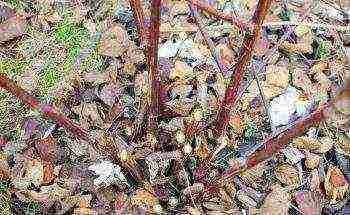
Leave only 6 or 7 stems during fall pruning
Blackberries are easy to care for. But still, she needs some measures:
- Watering. More frequent watering (twice a week) is needed only for a first-year seedling, from the second year of life it should be watered only when necessary (during a dry period), and also when the fruits are tied.
- Loosening. You need to do this procedure regularly, preferably after watering, at the same time removing weeds. To facilitate the work, you can use mulch - and the looseness of the soil will be preserved, and will protect from weeds.
- Top dressing. Blackberries may well be satisfied with covering mulch before winter. But if we are talking about increasing yields, then organic fertilizing with compost or humus is needed at the rate of 5 kg per square of soil, and during the ripening of the crop - fertilizing with potash fertilizers. Read also the article: → "Top dressing of bushes in spring"
- Pruning. The main pruning is in the autumn, done after the berries have been removed. It is necessary to cut out all the shoots, leave about six to eight strong current ones, shortening them by 1/3. In the spring, diseased and broken branches are removed. Pruning the tops will wake the plant up and provoke more active development. Read also the article: → "How to properly prune a blackberry?"
- Shelter. Protects from frost. To cover the blackberry, it is necessary to bend it to the ground and cover it with some covering material or mulch. Read also the article: → "What mulch to choose for blackberries?"
Answers to frequently asked questions about the blackberry
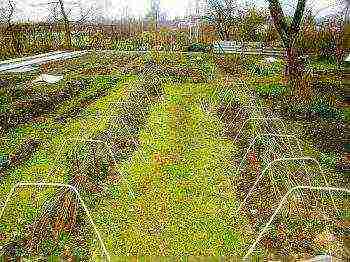
This is ideally what a blackberry prepared for wintering looks like. It remains only to cover
Question number 1... How to water a blackberry?
Despite the fact that blackberries do not like stagnant water in the soil, they need to be watered abundantly when the fruits are tied and the ripening period begins. Lack of water will lead to crushing of the berries, they will not gain the necessary juiciness and sweetness.
Question number 2... Is it possible to plant a blackberry next to a fence, will it have enough sun?
Indeed, for the climate of the Moscow region, sunshine is an urgent problem. But the fence here, in principle, has nothing to do with it. On the contrary, there are advantages: planting along the fence, firstly, will eliminate the need to make a trellis, and secondly, it will serve as a hedge.
Gardeners' mistakes when growing blackberries in the Moscow region
Blackberry is a thermophilic plant, and it is not easy for it in the climate near Moscow. In general, you don't need to help her, the main thing is not to interfere, and not to make mistakes in leaving, namely:
- Watering with ice water. Well or tap water is absolutely not suitable for watering blackberries. In principle, not the water itself, but its temperature. Do not use too cold water, let it be rainwater or heated in a barrel for a day.
- Berry burns with sunbeams due to lack of shelter. If you are not lazy and shade the area with blackberries, when berries ripen on it, you can avoid sunburn of delicate fruits and preserve their presentation and quality. A shading mesh stretched along the bushes, for example, will help with this.
- Forcibly bending down thick stems for shelter for the winter. This can lead to branch breakage and destruction of the bush. It is not worth bending down forcibly. But how to protect them from frost in the climate near Moscow? For the entire last summer month, you need to hang some heavy object on the tops of the shoots. The branches will bend by themselves under its weight. All that remains is to cover.
Rate the quality of the article. We want to be better for you:
Is it possible to grow an ideal blackberry variety in the country. Quite, despite the fact that America is considered the birthplace of this culture. In our article you will find a description of the best blackberry varieties for temperate climates.
Blackberries began to be cultivated in the 19th century in the United States, and most of the modern varieties come from there. There are two main varieties of blackberries: dewberry (ozhina, gray blackberry) - a creeping shrub and kumanika (nessa blackberry) - an erect shrub with slightly drooping branches. Summer residents prefer the latter option, since it is kumanika that is distinguished by good winter hardiness and gives juicy berries of medium size. However, among the varieties of blackberries there are also absolute leaders in consumer preferences. Let's find out which varieties are considered the best for growing in the middle lane.
Agave
This is one of the first artificially bred blackberry varieties, known since the second half of the 19th century. It has been cultivated in the CIS for more than half a century. Strong shoots grow vertically, and the winter hardiness of the plant is beyond praise - it is not afraid of frosts down to –30 ° C. Berries ripen medium, black, with shine. At first, they taste like a forest blackberry. As they ripen, the amount of sugar in the berries increases, but they themselves begin to deteriorate. Curiously, this blackberry can even grow on its own, in the place of uprooted bushes.
| Appointment | Productivity (kg per bush) | Berry weight (g) |
Fruiting (period) |
Bush height (m) | |
|
8-10 |
3-5 |
August - early September |
2-2,2 |
||
Apaches
"Unbending sissy from Arkansas" - this is the nickname received by this variety, known in the CIS since the early 2000s. Berries are wide, conical in shape, very large, rich black color with a glossy sheen. They do not shrink, and even when they hang on the bushes for a long time, they do not lose their presentation, do not wrinkle and do not flow during transportation. The taste is harmonious and sweet with appropriate sourness. The plant does not tolerate extreme heat very well (drip irrigation will help out) and severe cold (shelter for the winter will help).
| Appointment | Productivity (kg per bush) | Berry weight (g) |
Fruiting (period) |
Bush height (m) | |
|
6-8 |
7-9 |
Mid July - mid August |
2-2,5 |
||
Black Satin
The variety is famous for its powerful and vigorous bushes, which easily grow into two or even three human heights. The shoots are completely devoid of thorns and after the 1.5-2 m mark they begin to creep horizontally, so the bushes need garters. The berries are round, slightly elongated, pleasant and sweet in taste with a slight sourness. Due to its high yield, the variety is recommended for both private and industrial cultivation. It is better to pick the berries within 3-4 days after ripening so that they do not crumble or dry out.
| Appointment | Productivity (kg per bush) | Berry weight (g) |
Fruiting (period) |
Lash length (m) | |
|
15-17 |
4-7 |
End of July - beginning of August |
5-7 |
||
Karaka Black
This is a very complex hybrid, obtained as a result of repeated crossing of different varieties of blackberries and raspberries. The berries are large, elongated, tapering downward, glossy, with good taste and aroma, suitable for long-term storage, freezing and transportation. The yield is high, the resistance to unfavorable weather conditions, diseases and pests is average. The variety has one distinctive feature - the leaves on the bushes can sometimes turn yellow, but this is not a sign of the disease.
| Appointment | Productivity (kg per bush) | Berry weight (g) |
Fruiting (period) |
Lash length (m) | |
|
8-12 |
8-10 |
June August |
3-5 |
||
Ruben
The first of the known remontant varieties that bears fruit on the shoots of the current year. The seedlings only went on sale in 2011, so Ruben is the newest high-yielding variety. Bushes grow vertically, like raspberries, compact and do not require trellis support. The plant perfectly tolerates autumn frosts and winter temperatures below zero. The berries are large, very sweet, well transported over long distances. Fruiting continues almost until the autumn frosts, so you can eat fresh blackberries even when all the other berries have already been picked.
| Appointment | Productivity (kg per bush) | Berry weight (g) |
Fruiting (period) |
Bush height (m) | |
|
13-15 |
8-10 |
End of August - end of October |
1,5-1,8 |
||
Thornfree
This is one of the most unpretentious and productive varieties that easily adapts to our cold winters and resists most diseases. In one place, the bush can grow up to 30 years. There are no thorns on it, but it blooms very beautifully, and many berries ripen on the branches at the same time. They are bluish-black, fleshy, dessert-like. And these are far from all the advantages of Thornfrey, which remains one of the best varieties for personal and commercial use, known since the 1960s.
| Appointment | Productivity (kg per bush) | Berry weight (g) |
Fruiting (period) |
Bush height (m) | |
|
13-15 |
7-9 |
August |
2-2,5 |
||
Chester
One of the most frost-resistant varieties (withstands temperatures down to –26 ° C). The bushes are of a semi-spreading type, therefore, sometimes for better growth and development, they are tied to a trellis. The size of the berries ranges from medium to large, they are dark blue in color with a bright shine. The taste of blackberries is sweet, enriched with a slight sourness. Ripe berries are very strong and dense, which allows them to be transported over long distances. Another distinguishing feature of the variety is its high yield.
| Appointment | Productivity (kg per bush) | Berry weight (g) |
Fruiting (period) |
Bush height (m) | |
|
15-20 |
5-7 |
End of July - beginning of August |
1-1,5 |
||
We have listed here just a few of the most popular and best varieties, which have demonstrated excellent yields and resistance to various diseases, as well as weather events. We look forward to hearing from you on our forum a description of the varieties that you grow on your plots.
Blackberries are a tasty and healthy berry that is very popular in private gardening. Many land owners dream of seeing dark purple fruits in their beds, containing many vitamins and minerals. The task is not that difficult, provided that the “right” varieties are selected for cultivation. In this article, you will find out which blackberries are the best.
Short description
Blackberries began to be cultivated in the United States in the 19th century. Most of the species were bred there, in natural conditions. At the moment, there are about 300 varieties. This diversity is explained by the fact that plants easily interbreed with each other, showing the world more and more new hybrids.
Blackberry is a perennial shrub most often covered with thorns. Depending on how the stems grow, a distinction is made between kumanika (erect branches) and dewdrop (creeping branches). Leaves are complex. Flowers - self-pollinated, large, collected in a brush. The fruit is a drupe.
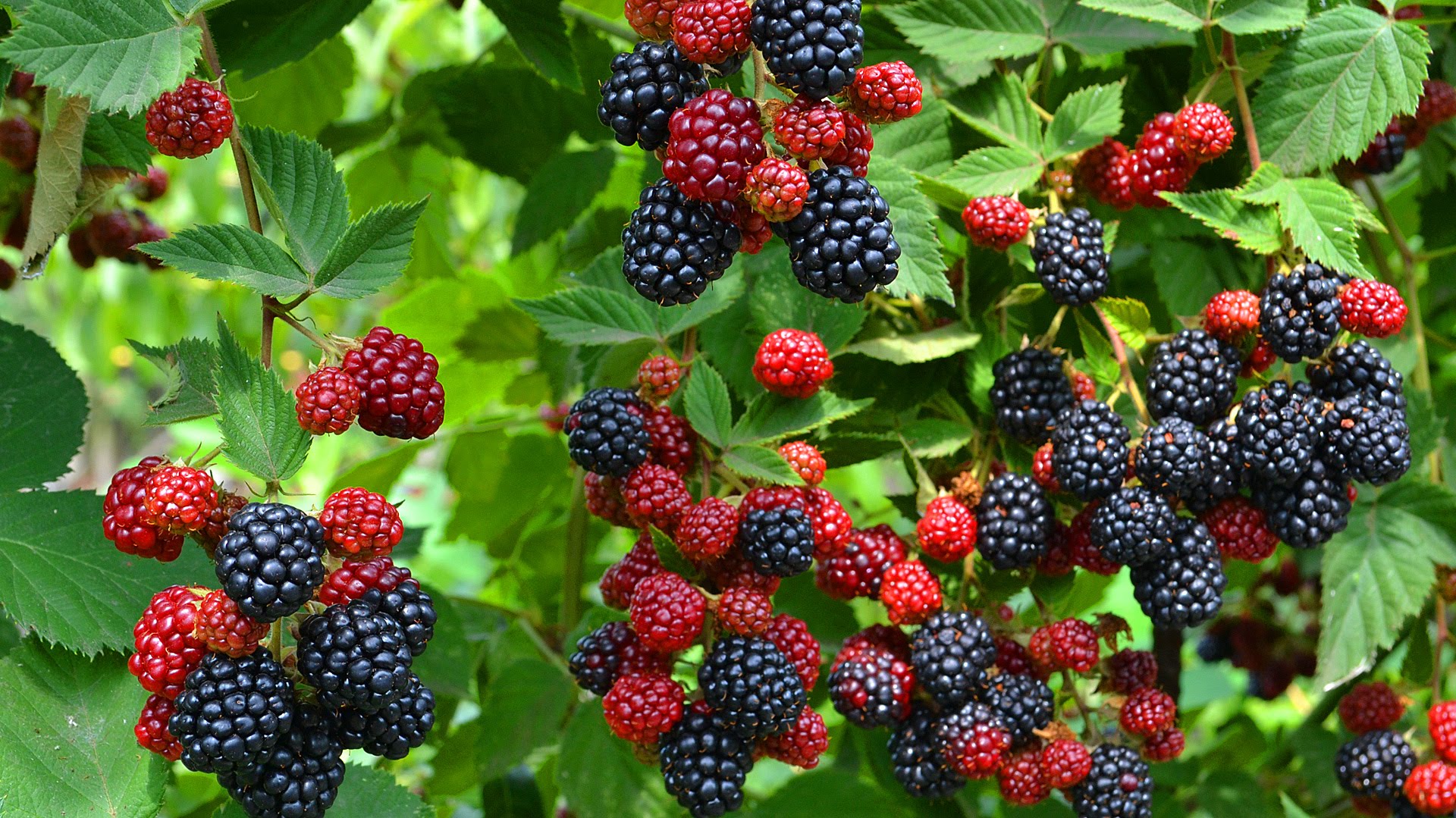
Berries contain iron, calcium, potassium, manganese, phosphorus, organic acids, vitamins C, A, K, PP, fiber, amino acids. Blackberries have antipyretic, anti-inflammatory, anti-edematous and bactericidal effects. It normalizes blood pressure, calms the nervous system, removes toxins, and speeds up metabolism.
Blackberry teas and decoctions are prescribed for obesity, neurosis, constipation, diabetes mellitus, liver and bladder diseases.
The best varieties of blackberries
As you can see, there are enough reasons to grow blackberries in your beds. Now let's choose varieties that are guaranteed to take root and give a stable harvest.
Agave
This variety was bred almost 100 years ago. A thorny bush with erect stems reaches a height of 2 meters. The thorns are long and curved, which makes harvesting difficult. One of the main benefits of blackberries is their resistance to low temperatures. It perfectly tolerates temperatures up to -30 degrees.
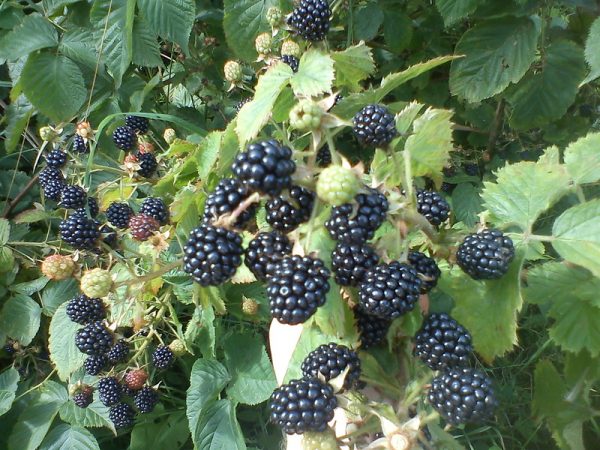
The berries are medium in size, black, with a characteristic shine. The taste is sweet and sour. Blackberries ripen in August-September. From one bush, you can get 10 kg of fruit. The plant takes root without any problems. Moreover, if you do not regularly remove new shoots, Agaves will take up the whole garden.
Doyle
The result of the efforts of foreign breeders is recognized as one of the most productive in the world. In this regard, it is listed in the Guinness Book of Records. The large number of berries is explained by the fact that the plant forms many lateral branches (about 50 cm long) with countless fruits. A significant plus of the variety is the absence of thorns.
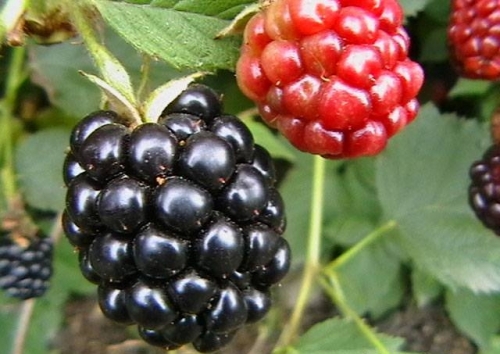
Black fruits are juicy and large. Weight - up to 5 grams. The shape is elongated. The taste is sweet and sour, very pleasant. They tolerate transportation well. Blackberries are frost and drought resistant. Rarely sick. The fruiting period lasts from July to September.
Apaches
Obtained after lengthy experiments on crossing the Navajo variety and the "test" one for that period, sample Ark.1007. The result exceeded all expectations. Large conical black berries retain their original size throughout the season, do not flow or wrinkle during transportation. The taste is sweet, with a pleasant sourish flavor.
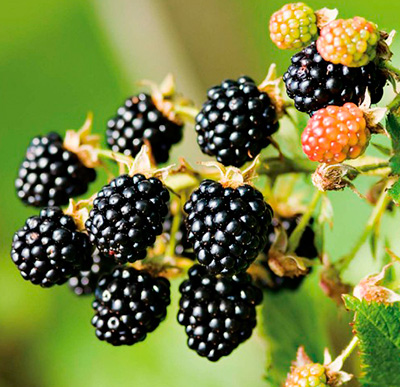
The yield is average. From one bush - 7-8 kg of berries. The fruits are harvested from June to August. The plant can withstand temperatures up to -20 degrees, if the thermometer drops below - it requires shelter. Doesn't like drought. In the hot period, the bush must be often watered and shaded with nets or agrofibre.
Black Satin
The variety was bred in 1974. The name was not chosen by chance - the breeders wanted to emphasize the tenderness and silkiness. A semi-shrub with powerful branches, after reaching a certain height, bends to the ground. Shoots sometimes grow up to 5 meters, so they need reliable support.
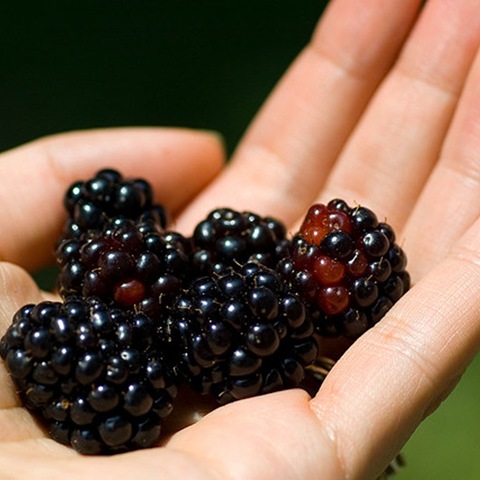
The berries are large. Weight varies from 5 to 8 grams. Collected in spectacular black tiered brushes. Ripe blackberries are sweet and soft. Wrinkles quickly during transportation. Yield indicators are high. Under favorable conditions, 14-17 kg of fruits are harvested from one bush. It is recommended to harvest immediately after ripening. If this is not done, the blackberries will shrink and crumble.
Karaka Black
The result of multiple crossing of different varieties of raspberries and blackberries. The main advantage of this thorny variety is the fruit. They look unusual - large (10 gr.) Oblong berries taper at the end. The surface is shiny.The taste is memorable, sweet with pleasant sourness. Due to their high density, blackberries are stored and transported for a long time without loss of marketability.
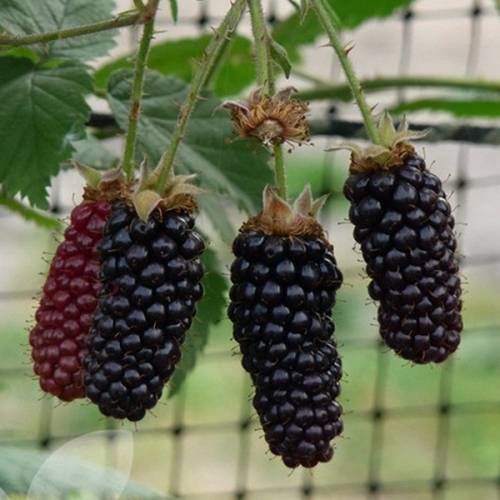
The disadvantage of Karak Black is sharp thorns. Wear thick gloves when handling the bush. One plant produces from 8 to 10 kg of fruits. Harvested from June to August. The variety does not tolerate cold well - protect it from frost, but it is resistant to pests and diseases. Sometimes the leaves begin to turn yellow - this is not a cause for concern, but a distinctive feature of the variety.
Ruben
It appeared not so long ago - in 2011. He immediately won the favor of gardeners. The shrub is short and compact. The branches are flexible, do not break even under strong wind gusts, without thorns. The variety tolerates low temperatures well - you do not need to cover for the winter. Fruiting lasts until the first frost.
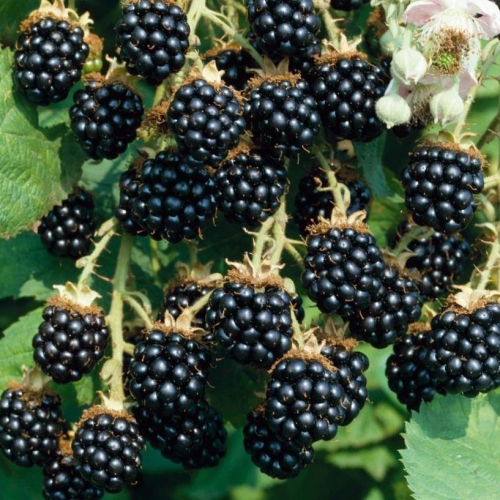
The berries are large (4-5 cm long), sweet. They do not lose their original appearance during transportation. From one bush, you can get 14-15 kg of fruits. Ruben is good because it provides an opportunity to feast on delicious blackberries, when everything has been collected from the bushes of other varieties for a long time.
Thornfree
This variety is the dream of any summer resident. Unpretentious to the surrounding conditions, easy to care for, resistant to frost and disease. It grows in one place for a long time - about 30 years. Bred in the USA in 1966. It is very popular to this day.
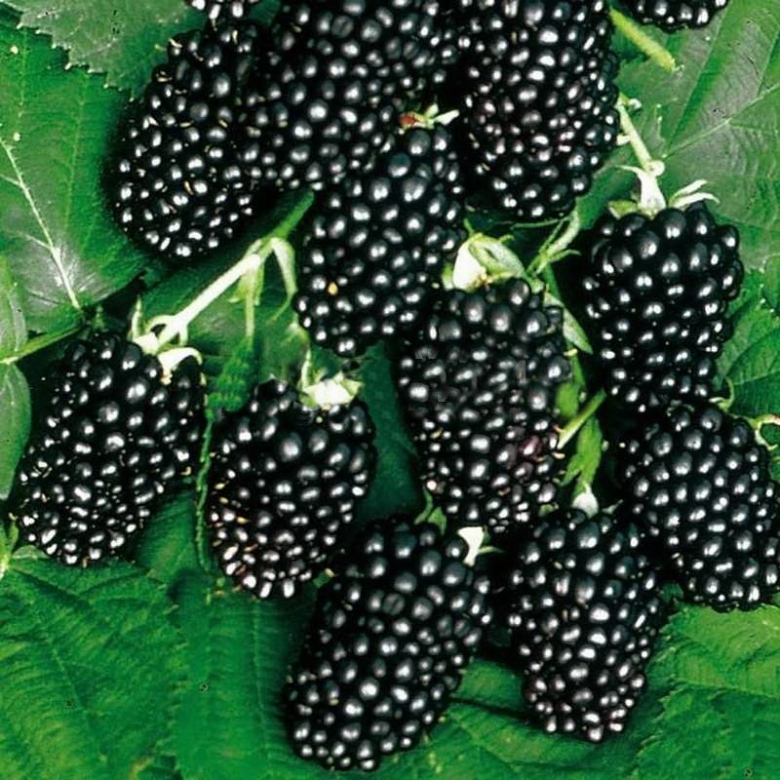
The main advantages are the absence of thorns, amicable ripening of berries, high decorative qualities of the bush, multi-berry brushes. One plant produces up to 12 kg of fruits. The berries are dark blue, juicy. The taste changes as it ripens: first - sour, then - sweet and sour, after full ripening - freshly sweet. Fruiting occurs in August.
Loch Tay
A thornless variety with large fruits. The plant is tall, erect. Shoots - powerful, resilient, in need of support. The variety is prized for its drought tolerance, good yield and extraordinary taste. The berries are elongated, black, with a glossy surface. A dry sepal signals maturity; in unripe blackberries, it is green.

Fruits are homogeneous in structure, dense, do not crumple during collection and transportation. They taste harmonious, rich, sweet, with a pronounced fruity aroma. Blackberries ripen in July. Berries can be picked either manually or mechanically.
Arapaho
Somehow the experts set themselves the goal of creating a strong, upright thornless variety characterized by early ripening. This is how Arapaho appeared. Many people fell in love with blackberries, because they combined the advantages of long-known species.
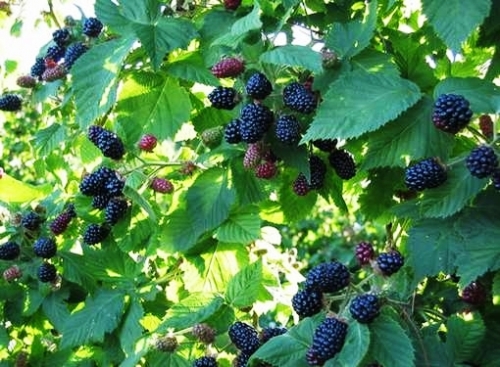
Fruits are short, conical, dark black in color. The taste is also excellent. Many people call this variety the best in terms of aroma and taste. The plant tolerates a drop in temperature to -25 degrees well and in most cases hibernates without shelter. The berries mainly appear on the side branches. In this regard, it is recommended to pinch the upper shoots, which stimulates their growth.
Polar
This blackberry attracts with good yields with minimal physical costs. The variety was bred in Poland in 2008. Experts have been working on its appearance for over 30 years. Straight shoots without thorns reach a height of 2.5 meters or more.
The glossy black berries have a neat oval shape. The taste is amazing, very pleasant and sweet, without the usual astringency. From one bush, about 7 kg of fruits are obtained.
Polar is distinguished by early ripening and long-term fruiting. Harvesting is possible from July to September. The plant retains its inherent characteristics even after long transportation. Disease and pest resistant.
Osage
The hottest new product to date. A patent for this variety has not yet been obtained and there is very little information about it. It is known to be a thornless shrub with straight stems. Easily withstands temperatures down to -13 degrees. Disease resistant.
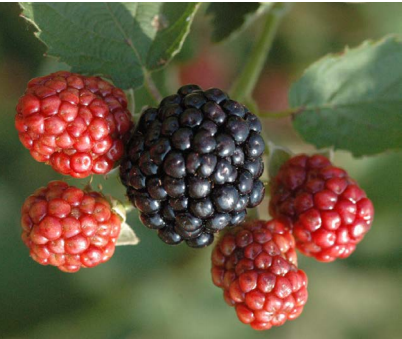
Berries have great industrial potential due to their adaptability to long-term transportation and storage. Fruits are round in shape, weighing 5 g. As for taste, when creating this variety, John Clarke said: "I dream of developing a variety that I would like to eat without stopping, even a whole bucket." It looks like he succeeded.
Here are the 10 best blackberry varieties, distinguished by high yields, amazing taste, resistance to low temperatures and pests. Choosing one of them, you can't go wrong, because you get the opportunity to enjoy delicious berries throughout the whole summer and even half of autumn.
Video tips for growing blackberries
